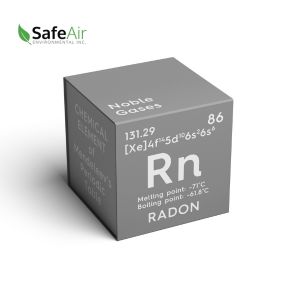What You Need to Know to Keep Your Home Safe From Radon
Posted in Radon Testing, on January 22, 2024
Radon testing — maybe your neighbour has recently done it, or you’ve seen testing kits at the hardware store. If so, you’re like many folks considering the benefits of air quality testing in Toronto this coming year. With increased awareness of this colourless, odourless gas, many Torontonians have called to ask the SafeAir team about testing their home for radon gas. While it’s been around since the earth's formation, the dangers and severe health consequences of radon exposure are only now becoming widely known. Here is what SafeAir thinks you need to know to keep your home safe from radon gas.
Understanding Radon
 Formed many kilometres deep in the earth’s surface, radon gas is a radioactive byproduct of uranium. Typically, radon gas filters through the ground and harmlessly dissipates into the atmosphere. However, the negative pressure formed by basements can attract this gas, entering our houses through cracks and gaps in the foundation.
Formed many kilometres deep in the earth’s surface, radon gas is a radioactive byproduct of uranium. Typically, radon gas filters through the ground and harmlessly dissipates into the atmosphere. However, the negative pressure formed by basements can attract this gas, entering our houses through cracks and gaps in the foundation.
Concentrated radon gas has no smell and is invisible — you don’t know you’re being exposed until it’s too late. After cigarette smoking, radon gas is the leading cause of lung cancer in Canada. Cancer happens after the radioactive radon particles are breathed in, where they cause irritation, inflammation, and cellular changes to the lungs and respiratory system.
Testing for Radon
The good news is that testing for radon gas in your home is easy! At SafeAir, we offer radon testing as a stand-alone service or as part of general air quality testing in Toronto. When you have a radon test at home, a SafeAir technician will come for a short visit to place a discreet testing device in your lower levels. This device sits for 3-6 months without needing service or prompting. When the testing period is over, we uninstall it and send it to the lab for analysis.
Long-term radon testing removes the risks of false positives and helps even out any spikes in the radon level caused by seasonal or temperature changes. In Canada, results below 200 Becquerels per cubic metre or less are considered safe.
Radon Mitigation
You must consider radon mitigation strategies if your house tests above 200 Bq/m3. We may suggest several different fixes depending on various factors, such as your home’s age, construction, location and risk.
Often, sealing cracks in the foundation or installing radon exclusion devices on pipes or water sources is all that’s needed. Like many indoor air quality issues, radon gas can often be improved by increasing ventilation. More severe problems may need specialised pumps or air interventions to prevent buildup.
Work with SafeAir to Eliminate Radon
Radon testing is something that, like electrical work, is best performed by a professional for safe and effective results. At SafeAir, we’ve been testing radon in Toronto for over a decade, following the latest advances in procedures and tools as set out by industry standards and regulations. This gives our results an edge over DIY testing, ensuring that you and your family have accurate results. To learn more about indoor air quality testing or how radon gas may affect you, contact SafeAir today!

